Each and every year, over 25 million cars and trucks pass right over one of the hottest fishing spots around for Chesapeake Bay fishing. And while the people in those cars may be thinking about which lane is faster or why the backup continues past the toll plaza, those of us floating around below them are thinking about something entirely different: how to catch more, bigger fish. Before we dive deep into the details, check out this short video we shot with Angler's Sport Center, specifically on fishing at the Chesapeake Bay Bridges.
Okay - now for those of you who have a longer attention span and can soak up some fishing knowledge via reading, as well as video...
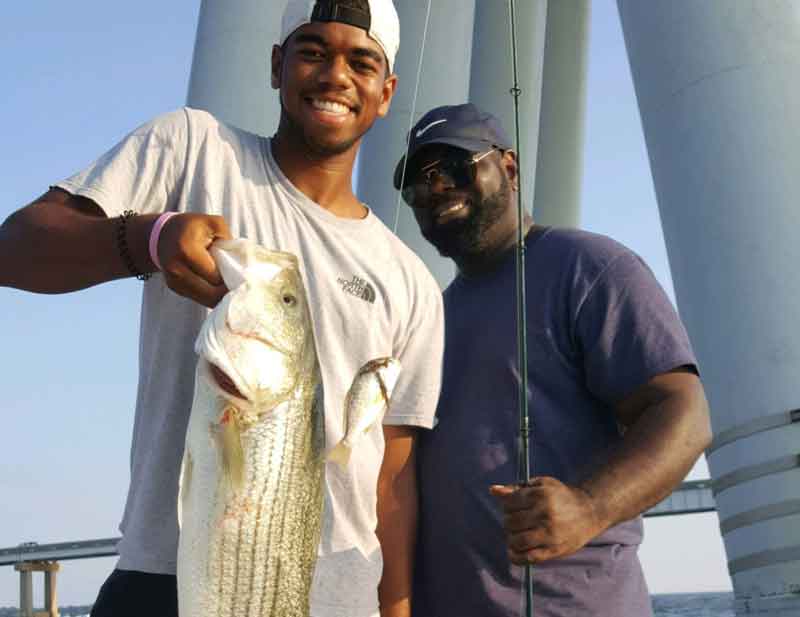
We’ve examined jigging at the Chesapeake Bay Bridge pilings before and live-lining and chumming here have dominated the Upper Bay fishing reports and the Middle Bay fishing reports through much of the striper season for two years running. So instead of dwelling on a particular method or tactic, this month we’re going to look at how to approach the bridge as a whole – the complete package, so to speak.
The Number-One Bridge Fishing Tip
Fishing at the bridge changes. Sometimes it’s a slow change and sometimes it changes overnight, but the biggest danger to anglers who fish here regularly is thinking that what worked yesterday will work again tomorrow, next week, next month, and next year – and that it’s the only thing that will work. In the 70s trolling over deep-water sections of the bridge was our standard tactic. During parts of the 80s the rockpiles held all the fish. In the 90s it was the Western Shore pilings, then the Eastern Shore pilings, then the rockpiles again. And from the turn of the century to today we’ve seen the same sections of the bridge complex go from hot to not, and back to hot again. The bottom line: don’t get myopic, don’t fall into a rut, and don’t have a conniption if there are five boats clustered around your favorite piling. There are literally dozens of places and tactics to try at the bridge and even though one or another was red-hot yesterday, that doesn’t it’s the only one that will work and it doesn’t mean you can count on it working tomorrow.
Now let’s break that concept down a bit: not only does fishing at the bridge change through time, it changes through tidal cycles. Fish the bridge long enough, and you’ll experience days when the best bite is on the eastern side during one tide, but on the western side during the other. Fish it a little longer, and you’ll experience days when the diametric opposite occurs.
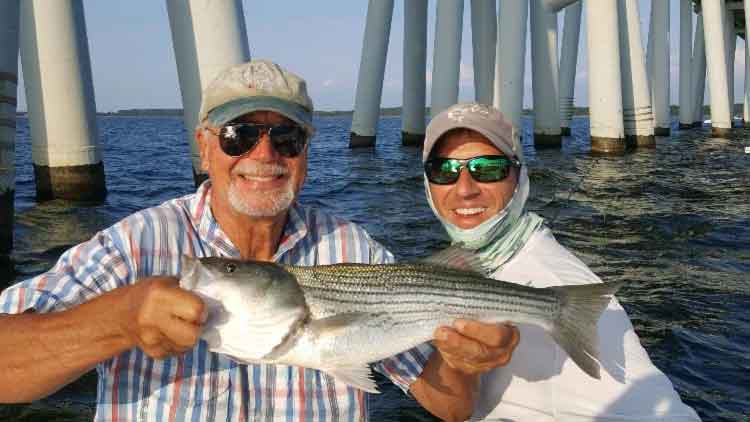
You’ll also encounter timeframes when specific structures at the bridge require modifying your location according to the tide. The best bite at the east rockpile, for example, is often on its western side during an outgoing tide. But on an incoming, the northern side usually produces best. Larger pilings can display the same micro-hotspot specificity.
Be Your Boat
The second-most important thing to keep in mind about fishing the bridge is probably remembering that with raging currents, lots of structure to slam into, and plenty of other boats in the area, boat handling is a key to being successful here. In many situations you’ll have to dedicate yourself to running the boat, and constantly jockeying the throttles to maintain safe and proper casting distances, positions, and drifts. You have to get your anglers into the right spot, and then trust them to do the catching while you grab a cast or two when possible.
Wait a sec – why not just anchor up, and not worry so much about handling the boat? Sure, that’s an option. In fact, when other boats are anchored up around the bridge it’s often the only acceptable option. But this shouldn’t always be the first choice because a) multiple boats can work a piling adrift while one anchored boat cuts other anglers out of the action and/or forces them to move in too close to get a shot; b) you stand a good chance of losing an anchor around the bridge, c) dropping anchor reduces your flexibility and forces you to dedicate yourself to one single spot for longer than you might otherwise; and d) it raises the element of danger, because an errant wave, gust of wind, or changing tide can turn a safe anchor job into a piling-slammer in the blink of an eye.
All of that said, many sections of the bridge have been so crowded with anchored boats the past few seasons that it’s been discourteous and dangerous to try fishing in the area without dropping the hook. The bottom line? Whether to anchor up on not is each individual captain’s choice on any given day, but you should consider the current situation and think a bit before reaching for the ground tackle.
There’s one more very big and very important exception to consider: virtual anchoring. I can’t even begin to express how jealous I’ve become when I see a boat with a Minn Kota on the bow, Spot-Locked in place 20 feet from a piling. My boat doesn’t have this capability (and unfortunately can’t be rigged with it) but I’ve fished on plenty of boats with either bow-mount electrics or Helm Master systems that allow for button-press GPS position holding – and it’s an invaluable advantage.
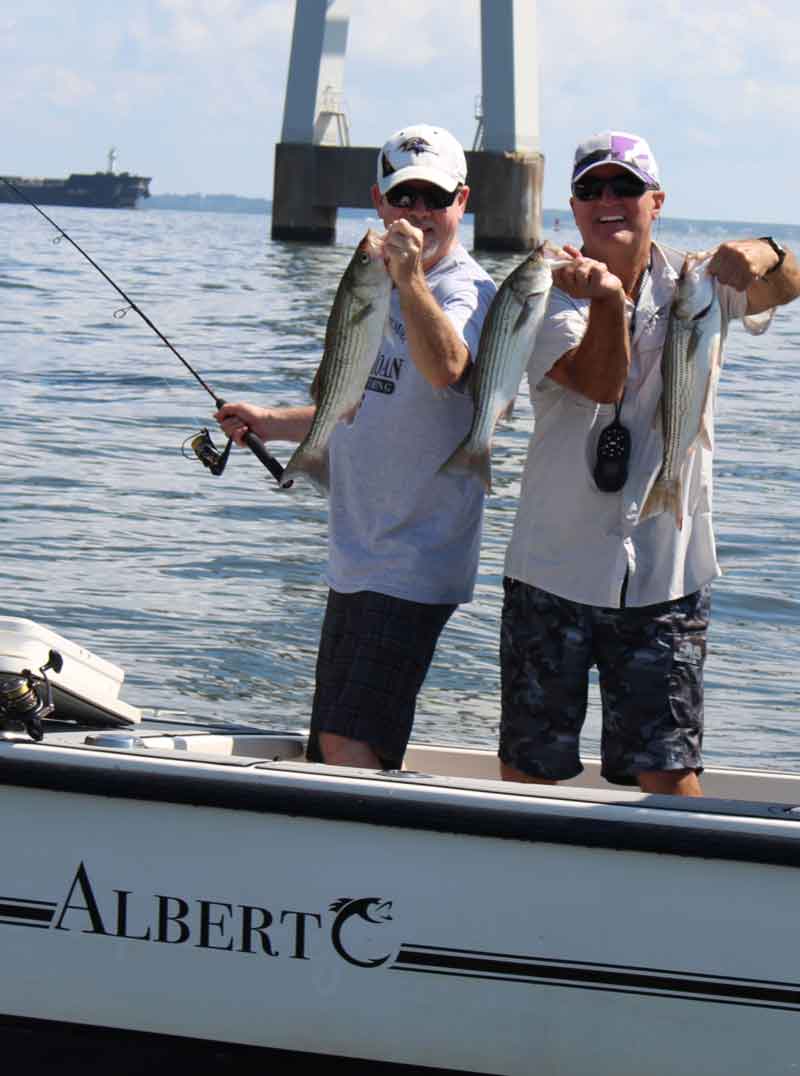
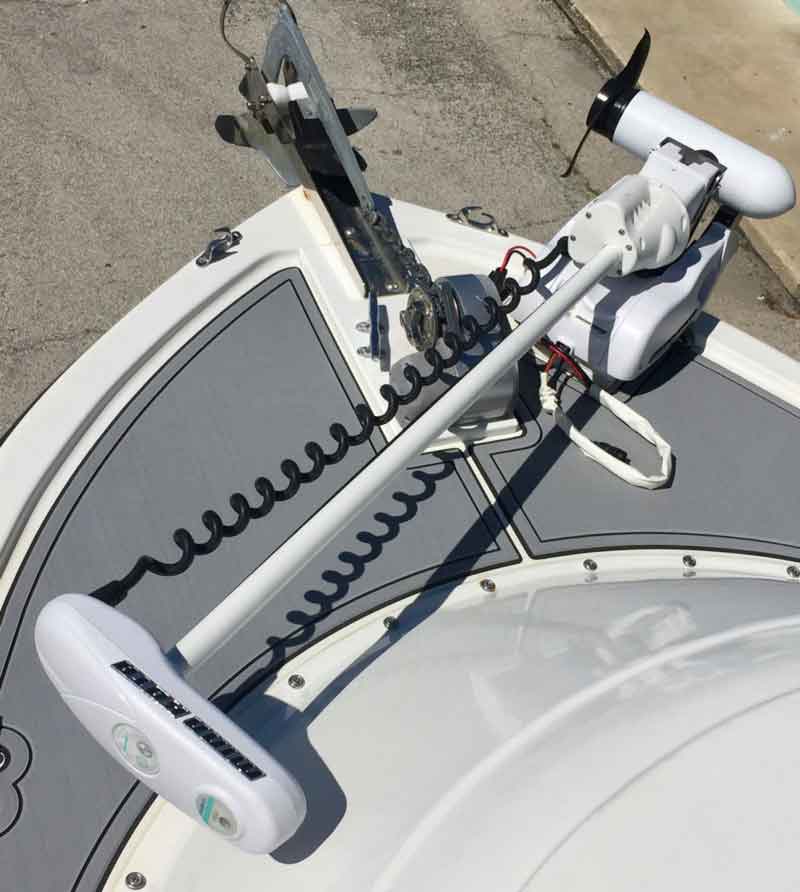
Keep Hopping at the Bay Bridge
The aforementioned crowds notwithstanding, one of the most effective ways to approach this wonder of mass fishing structure is to hop from one spot to the next, working your way along the different teepee-style pilings, cross-bars, four-leggers, and rockpiles. The specific tactic you’re using can vary with this approach. Slinging jigs is a favorite of many, but tossing live spot or soft crab chunks will also work as you go hopping from one spot to the next.
The most important thing to remember about this technique is that you’re essentially prospecting just as you would when casting to a long rip-rap jetty, and similarly, you’ll want to stay on the move. Having a good side-scanning sonar is a huge help in this situation, since you can tell if there are fish schooling around a piling merely by passing slowly along and keeping an eye on the screen. Combine this tactic with a trolling motor that has Spot-Lock and is interfaced with your MFD (note that Minn Kota and Humminbird are sister companies and Solix or Helix models can be integrated into what they call the “One-Boat Network,” so they communicate seamlessly with each other) and you can greatly reduce the amount of time you spend casting blindly at barren water.
Whether you see fish or don’t have the ability to, three or four casts at a single piling is plenty – if there are no hits, be quick to move on because any fish you may see could be inactive. If someone felt a bump or two maybe give the piling an extra cast. If someone lands a throwback give the piling a half-dozen more chances, and if a keeper comes to the net plug away at the spot for a few minutes.
On rule: don’t bounce north-south between the two bridges as you hit one piling after the next, but instead work east-west. Usually one side or the other will have a better bite, but it’s rare that the north bridge will be a whole lot better than the south bridge, or vise-versa, as you work your way along. (That’s looking at the bridges as a whole; specific pilings are different and there are a few both on the north span and on the southern span that stand out on their own individual merits).
North-South-East-West
That said, as a general rule of thumb the south bridge pilings tend to be better on the western side, and the north bridge pilings tend to be better on the eastern side. Yes there will be exceptions – many exceptions – but over the long term this tends to be the case. And here’s another overly-generalized statement that is most certainly not 100-percent true, but does is likely to be correct when looking through a long-term lens: on an incoming tide the western side (south span) is often a better bet, but on an outgoing the eastern side (north span) is often a better bet.
Taking all of these factors into consideration, when you arrive at the bridge on an incoming tide a solid game plan is to start on the western side, south span and work your way east. After hitting the rockpiles, then run to the eastern side edge where the bottom comes up from the old Susquehanna riverbed channel and switch to the north span. If you arrive during an outgoing, try running the same play but in reverse.
Can you count on the Bay Bridge to produce fish each and every time you visit? Of course not – there’s not a hotspot in the world that’s quite that good. But the bridges do stand head and shoulders above many other locations on the Bay. And one thing is for sure: no matter what the bite’s like, you’ll be having a heck of a lot more fun than the people in those cars passing overhead.
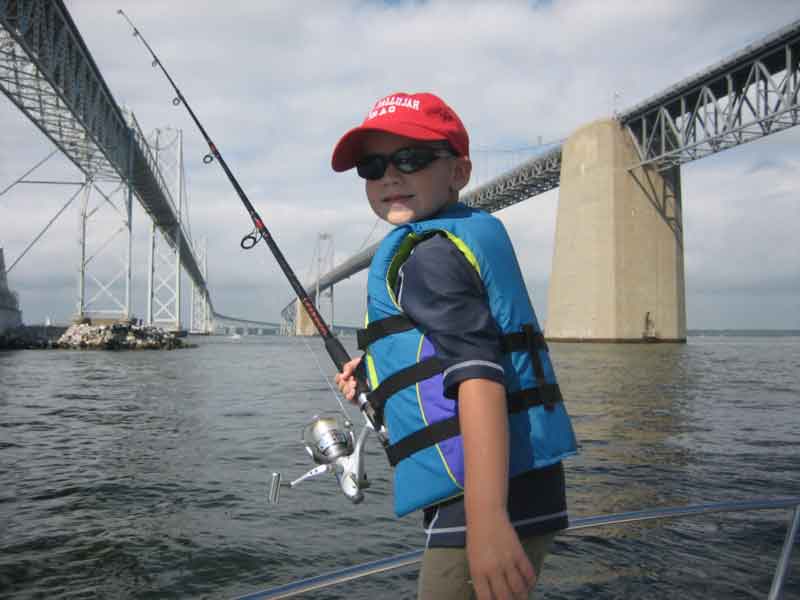
Old Fishing Techniques that Still Work Today
When I was a kid back in the 70s fishing at the bridge was mostly a trolling game, though drifting eels up against the pilings was also a tactic we used now and again. Since then, however, a couple of effective methods have come and gone. Who knows why they fell out of vogue – both will still put fish in the boat and the smart money says that at times, may prove more effective than anything else you try.
Feather Jigging – Tie a triple swivel on your line, and clip a one- to two-ounce dipsy sinker onto one of the remaining eyes. Then add a four-foot section of soft mono leader to the third eye, and tie on a three- to four-inch feather jig (similar to a bucktail but tied with chicken feathers) in white, yellow, or chartreuse. Cast the rig out, and allow it to sink to the bottom. As soon as it hits begin reeling and every second or third revolution of the crank, jig the rod tip. Sometimes crank-crank-jerk works best, others crank-crank-crank-jerk wins. Keep a steady rhythm to the retrieve until the rig breaks the surface because sometimes fish will follow it right up to the boat, and strike at the last second.
Live-Baiting Bull Minnow – People may be calling jumbo bull minnow “Snakehead Destroyers” these days, but in the past many anglers thought of big bulls as prime striped bass baits whenever fish were staging near the rockpiles. Rig a regular top-and-bottom rig with thin wire 1/0 to 2/0 hooks, and add an ounce or two of weight. Drop the rig down to the bottom, then give it a couple cranks so it stays above the snags as you drift along the rockpile’s edges. Full disclosure: I haven’t tried doing this since circle hooks became mandated and always used Js for this tactic, so I can’t swear as to whether you should allow the fish to eat or begin reeling the moment you get a strike.
- By Lenny Rudow
Sign up here to get the weekly FishTalk Chesapeake Bay and Mid-Atlantic fishing reports in your email inbox, every Friday by noon.